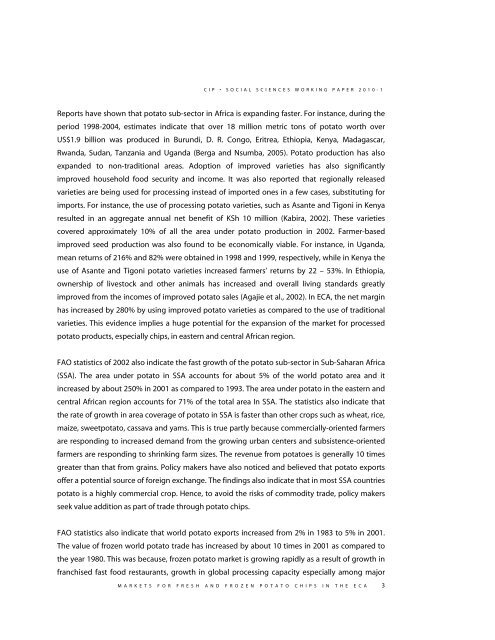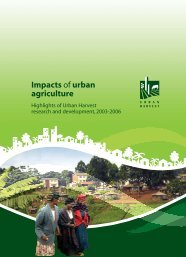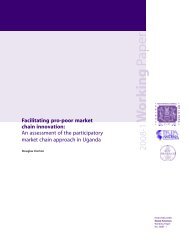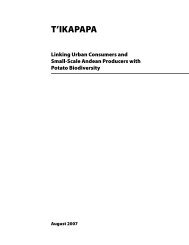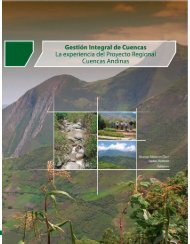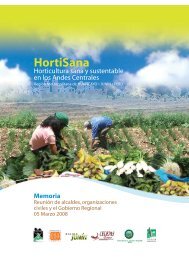Download pdf - International Potato Center
Download pdf - International Potato Center
Download pdf - International Potato Center
You also want an ePaper? Increase the reach of your titles
YUMPU automatically turns print PDFs into web optimized ePapers that Google loves.
CIP • SOCIAL SCIENCES WORKING PAPER 2010-1<br />
Reports have shown that potato sub-sector in Africa is expanding faster. For instance, during the<br />
period 1998-2004, estimates indicate that over 18 million metric tons of potato worth over<br />
US$1.9 billion was produced in Burundi, D. R. Congo, Eritrea, Ethiopia, Kenya, Madagascar,<br />
Rwanda, Sudan, Tanzania and Uganda (Berga and Nsumba, 2005). <strong>Potato</strong> production has also<br />
expanded to non-traditional areas. Adoption of improved varieties has also significantly<br />
improved household food security and income. It was also reported that regionally released<br />
varieties are being used for processing instead of imported ones in a few cases, substituting for<br />
imports. For instance, the use of processing potato varieties, such as Asante and Tigoni in Kenya<br />
resulted in an aggregate annual net benefit of KSh 10 million (Kabira, 2002). These varieties<br />
covered approximately 10% of all the area under potato production in 2002. Farmer-based<br />
improved seed production was also found to be economically viable. For instance, in Uganda,<br />
mean returns of 216% and 82% were obtained in 1998 and 1999, respectively, while in Kenya the<br />
use of Asante and Tigoni potato varieties increased farmers’ returns by 22 – 53%. In Ethiopia,<br />
ownership of livestock and other animals has increased and overall living standards greatly<br />
improved from the incomes of improved potato sales (Agajie et al., 2002). In ECA, the net margin<br />
has increased by 280% by using improved potato varieties as compared to the use of traditional<br />
varieties. This evidence implies a huge potential for the expansion of the market for processed<br />
potato products, especially chips, in eastern and central African region.<br />
FAO statistics of 2002 also indicate the fast growth of the potato sub-sector in Sub-Saharan Africa<br />
(SSA). The area under potato in SSA accounts for about 5% of the world potato area and it<br />
increased by about 250% in 2001 as compared to 1993. The area under potato in the eastern and<br />
central African region accounts for 71% of the total area In SSA. The statistics also indicate that<br />
the rate of growth in area coverage of potato in SSA is faster than other crops such as wheat, rice,<br />
maize, sweetpotato, cassava and yams. This is true partly because commercially-oriented farmers<br />
are responding to increased demand from the growing urban centers and subsistence-oriented<br />
farmers are responding to shrinking farm sizes. The revenue from potatoes is generally 10 times<br />
greater than that from grains. Policy makers have also noticed and believed that potato exports<br />
offer a potential source of foreign exchange. The findings also indicate that in most SSA countries<br />
potato is a highly commercial crop. Hence, to avoid the risks of commodity trade, policy makers<br />
seek value addition as part of trade through potato chips.<br />
FAO statistics also indicate that world potato exports increased from 2% in 1983 to 5% in 2001.<br />
The value of frozen world potato trade has increased by about 10 times in 2001 as compared to<br />
the year 1980. This was because, frozen potato market is growing rapidly as a result of growth in<br />
franchised fast food restaurants, growth in global processing capacity especially among major<br />
M A R K E T S F O R F R E S H A N D F R O Z E N P O T A T O C H I P S I N T H E E C A 3


